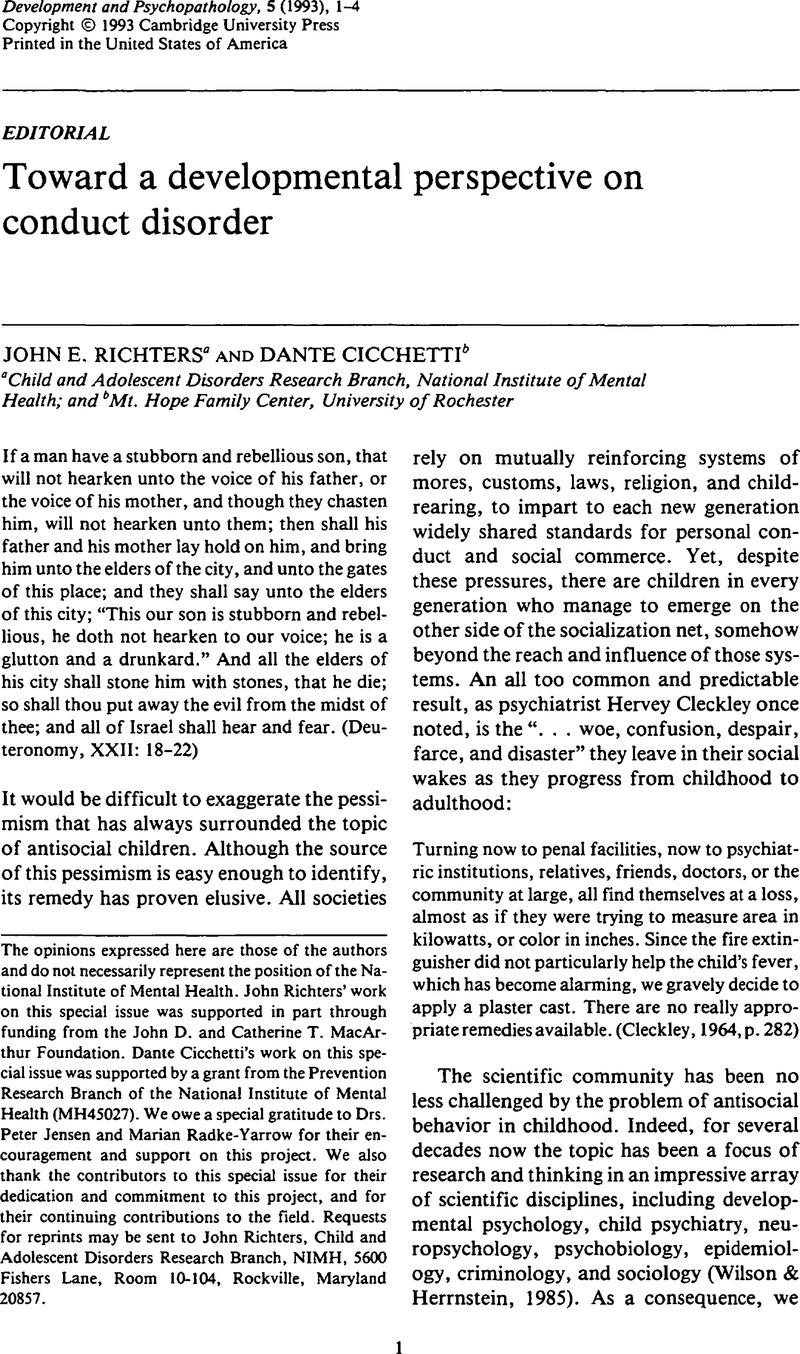Crossref Citations
This article has been cited by the following publications. This list is generated based on data provided by Crossref.
Cicchetti, Dante
and
Richters, John E.
1993.
Developmental considerations in the investigation of conduct disorder.
Development and Psychopathology,
Vol. 5,
Issue. 1-2,
p.
331.
Richers, John E.
and
Cicchetti, Dante
1993.
Mark Twain meets DSM-III-R: Conduct disorder, development, and the concept of harmful dysfunction.
Development and Psychopathology,
Vol. 5,
Issue. 1-2,
p.
5.
Blechman, Elaine A.
Prinz, Ronald J.
and
Dumas, Jean E.
1995.
Coping, competence, and aggression prevention: Part 1. Developmental model.
Applied and Preventive Psychology,
Vol. 4,
Issue. 4,
p.
211.
Callan Stoiber, Karen
and
Anderson, Arthur J.
1996.
Behavioral Assessment of Coping Strategies in Young Children At-risk, Developmentally Delayed, and Typically Developing.
Early Education & Development,
Vol. 7,
Issue. 1,
p.
25.
Stattin, Håkan
and
Magnusson, David
1996.
Antisocial development: A holistic approach.
Development and Psychopathology,
Vol. 8,
Issue. 4,
p.
617.
Blechman, Elaine A.
1996.
Coping, competence, and aggression prevention: Part 2. Universal school-based prevention.
Applied and Preventive Psychology,
Vol. 5,
Issue. 1,
p.
19.
Duncan, David F.
1996.
Growing up under the gun: Children and adolescents coping with violent neighborhoods.
Journal of Primary Prevention,
Vol. 16,
Issue. 4,
p.
343.
RICHTERS, JOHN E.
1996.
Disordered Views of Aggressive Children: A Late Twentieth Century Perspectivea.
Annals of the New York Academy of Sciences,
Vol. 794,
Issue. 1,
p.
208.
Werry, John Scott
1997.
Severe Conduct Disorder—Some Key Issues.
The Canadian Journal of Psychiatry,
Vol. 42,
Issue. 6,
p.
577.
Richters, John E.
and
Hinshaw, Stephen
1997.
Psychiatry's turbid solution..
Clinical Psychology: Science and Practice,
Vol. 4,
Issue. 3,
p.
276.
CONNOR, DANIEL F.
MELLONI, RICHARD H.
and
HARRISON, ROBERT J.
1998.
Overt Categorical Aggression in Referred Children and Adolescents.
Journal of the American Academy of Child & Adolescent Psychiatry,
Vol. 37,
Issue. 1,
p.
66.
Frick, Paul J.
1998.
Handbook of Child Psychopathology.
p.
213.
Frick, Paul J.
and
Loney, Bryan R.
1999.
Handbook of Disruptive Behavior Disorders.
p.
507.
Stern, Susan B.
and
Smith, Carolyn A.
1999.
Reciprocal Relationships between Antisocial Behavior and Parenting: Implications for Delinquency Intervention.
Families in Society: The Journal of Contemporary Social Services,
Vol. 80,
Issue. 2,
p.
169.
Evans, Gary W.
and
Saegert, Susan
2000.
Theoretical Perspectives in Environment-Behavior Research.
p.
247.
Frick, Paul J.
Bodin, S. Doug
and
Barry, Christopher T.
2000.
Psychopathic traits and conduct problems in community and clinic-referred samples of children: Further development of the Psychopathy Screening Device..
Psychological Assessment,
Vol. 12,
Issue. 4,
p.
382.
JONES, MARSHALL B.
and
JONES, DONALD R.
2000.
THE CONTAGIOUS NATURE OF ANTISOCIAL BEHAVIOR.
Criminology,
Vol. 38,
Issue. 1,
p.
25.
THOMAS, JEAN M.
and
GUSKIN, KAREN A.
2001.
Disruptive Behavior in Young Children: What Does It Mean?.
Journal of the American Academy of Child & Adolescent Psychiatry,
Vol. 40,
Issue. 1,
p.
44.
Kumpfer, Karol L.
2002.
Resilience and Development.
p.
179.
Kotler, Julie S.
and
McMahon, Robert J.
2005.
Child Psychopathy: Theories, Measurement, and Relations with the Development and Persistence of Conduct Problems.
Clinical Child and Family Psychology Review,
Vol. 8,
Issue. 4,
p.
291.



